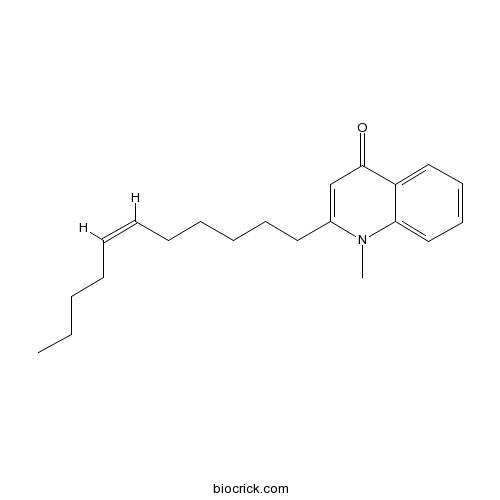(Z)-1-Methyl-2-(undec-6-enyl)quinolin-4(1H)-oneCAS# 120693-49-4 |

Quality Control & MSDS
3D structure
Package In Stock
Number of papers citing our products

| Cas No. | 120693-49-4 | SDF | Download SDF |
| PubChem ID | 5319810 | Appearance | Oil |
| Formula | C21H29NO | M.Wt | 311.46 |
| Type of Compound | Alkaloids | Storage | Desiccate at -20°C |
| Solubility | Soluble in Chloroform,Dichloromethane,Ethyl Acetate,DMSO,Acetone,etc. | ||
| Chemical Name | 1-methyl-2-[(Z)-undec-6-enyl]quinolin-4-one | ||
| SMILES | CCCCC=CCCCCCC1=CC(=O)C2=CC=CC=C2N1C | ||
| Standard InChIKey | ILAQTUNYLVMXNW-SREVYHEPSA-N | ||
| Standard InChI | InChI=1S/C21H29NO/c1-3-4-5-6-7-8-9-10-11-14-18-17-21(23)19-15-12-13-16-20(19)22(18)2/h6-7,12-13,15-17H,3-5,8-11,14H2,1-2H3/b7-6- | ||
| General tips | For obtaining a higher solubility , please warm the tube at 37 ℃ and shake it in the ultrasonic bath for a while.Stock solution can be stored below -20℃ for several months. We recommend that you prepare and use the solution on the same day. However, if the test schedule requires, the stock solutions can be prepared in advance, and the stock solution must be sealed and stored below -20℃. In general, the stock solution can be kept for several months. Before use, we recommend that you leave the vial at room temperature for at least an hour before opening it. |
||
| About Packaging | 1. The packaging of the product may be reversed during transportation, cause the high purity compounds to adhere to the neck or cap of the vial.Take the vail out of its packaging and shake gently until the compounds fall to the bottom of the vial. 2. For liquid products, please centrifuge at 500xg to gather the liquid to the bottom of the vial. 3. Try to avoid loss or contamination during the experiment. |
||
| Shipping Condition | Packaging according to customer requirements(5mg, 10mg, 20mg and more). Ship via FedEx, DHL, UPS, EMS or other couriers with RT, or blue ice upon request. | ||
| Description | 1. (Z)-1-Methyl-2-(undec-6-enyl)quinolin-4(1H)-one shows strong inhibitory activity on leukotriene biosynthesis in human polymorphonuclear granulocytes, and it is very effective against mycobacteria. |
| Targets | Antifection |

(Z)-1-Methyl-2-(undec-6-enyl)quinolin-4(1H)-one Dilution Calculator

(Z)-1-Methyl-2-(undec-6-enyl)quinolin-4(1H)-one Molarity Calculator
| 1 mg | 5 mg | 10 mg | 20 mg | 25 mg | |
| 1 mM | 3.2107 mL | 16.0534 mL | 32.1069 mL | 64.2137 mL | 80.2671 mL |
| 5 mM | 0.6421 mL | 3.2107 mL | 6.4214 mL | 12.8427 mL | 16.0534 mL |
| 10 mM | 0.3211 mL | 1.6053 mL | 3.2107 mL | 6.4214 mL | 8.0267 mL |
| 50 mM | 0.0642 mL | 0.3211 mL | 0.6421 mL | 1.2843 mL | 1.6053 mL |
| 100 mM | 0.0321 mL | 0.1605 mL | 0.3211 mL | 0.6421 mL | 0.8027 mL |
| * Note: If you are in the process of experiment, it's necessary to make the dilution ratios of the samples. The dilution data above is only for reference. Normally, it's can get a better solubility within lower of Concentrations. | |||||

Calcutta University

University of Minnesota

University of Maryland School of Medicine

University of Illinois at Chicago

The Ohio State University

University of Zurich

Harvard University

Colorado State University

Auburn University

Yale University

Worcester Polytechnic Institute

Washington State University

Stanford University

University of Leipzig

Universidade da Beira Interior

The Institute of Cancer Research

Heidelberg University

University of Amsterdam

University of Auckland

TsingHua University

The University of Michigan

Miami University

DRURY University

Jilin University

Fudan University

Wuhan University

Sun Yat-sen University

Universite de Paris

Deemed University

Auckland University

The University of Tokyo

Korea University
- Murrayacarpin B
Catalog No.:BCN3577
CAS No.:120693-44-9
- AM679
Catalog No.:BCC1354
CAS No.:1206880-66-1
- Midostaurin (PKC412)
Catalog No.:BCC5350
CAS No.:120685-11-2
- Bisacurone
Catalog No.:BCN6725
CAS No.:120681-81-4
- 6-O-Nicotinoylscutebarbatine G
Catalog No.:BCN7296
CAS No.:1206805-30-2
- LY2801653 dihydrochloride
Catalog No.:BCC1721
CAS No.:1206801-37-7
- LY2801653
Catalog No.:BCC1720
CAS No.:1206799-15-6
- 1-(3,4-Dihydroxyphenyl)-7-(4-hydroxyphenyl)hept-6-en-3-ol
Catalog No.:BCN7143
CAS No.:1206788-61-5
- 2''-Acetylastragalin
Catalog No.:BCN4810
CAS No.:1206734-95-3
- DMH-1
Catalog No.:BCC5329
CAS No.:1206711-16-1
- (RS)-PPG
Catalog No.:BCC6975
CAS No.:120667-15-4
- Geranyl ferulate
Catalog No.:BCN7078
CAS No.:1206615-69-1
- WAY 208466 dihydrochloride
Catalog No.:BCC7807
CAS No.:1207064-61-6
- Psidial A
Catalog No.:BCN6095
CAS No.:1207181-35-8
- Scutebata A
Catalog No.:BCN6096
CAS No.:1207181-57-4
- Scutebata B
Catalog No.:BCN6097
CAS No.:1207181-58-5
- Scutebata C
Catalog No.:BCN6098
CAS No.:1207181-59-6
- Scutebata E
Catalog No.:BCN6099
CAS No.:1207181-61-0
- Scutebata F
Catalog No.:BCN6100
CAS No.:1207181-62-1
- Scutebata G
Catalog No.:BCN6101
CAS No.:1207181-63-2
- Sarcandrolide D
Catalog No.:BCN6621
CAS No.:1207185-03-2
- 12alpha-Hydroxyevodol
Catalog No.:BCN6102
CAS No.:120722-04-5
- NVS-CRF38
Catalog No.:BCC8059
CAS No.:1207258-55-6
- BI-847325
Catalog No.:BCC6511
CAS No.:1207293-36-4
Evaluation of the Anti-inflammatory Potential of Chinese Botanicals
Planta Medica, 2009, 75(4):401-402.
Traditional Chinese medicine (TCM) has been using about 1300 plants for anti-inflammatory purposes. Activity guided isolation in a medium throughput approach has resulted in the discovery of a number of new drug leads. From the fruits of Evodia rutaecarpa (Juss.) Benth. (Rutaceae), several quinolinone alkaloids, like 1-methyl-2-nonyl-4(1H)-quinolinone, 1-methyl-2-(6Z)-6-undecenyl-4(1H)-quinolinone((Z)-1-Methyl-2-(undec-6-enyl)quinolin-4(1H)-one ), 1-methyl-2-(4Z,7Z)-4,7-tridecadienyl-4(1H)-quinolinone, evo-carpine and 1-methyl-2-(6Z,9Z)-6,9-pentadecadienyl-4(1H)-quinolinone, have been isolated which showed strong inhibitory activity on leukotriene biosynthesis in human polymorphonuclear granulocytes [1]. They showed no cytotoxic activity and might bind to the lipid binding site of 5-LOX [2]. Moreover they were very effective against mycobacteria [3].


